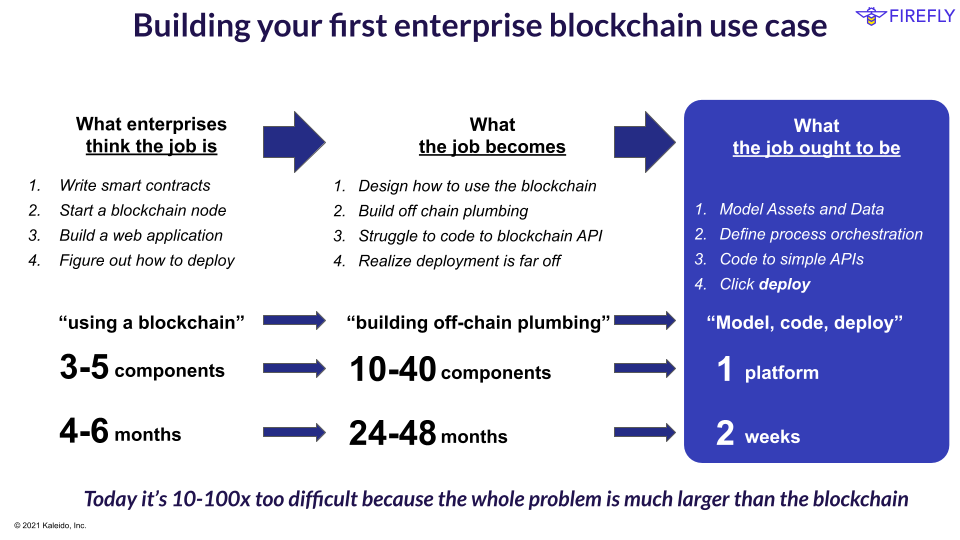The FireFly problem statement
Table of contents
The importance of the application layer
Multi-party systems always have an application layer, and what makes them different to a third party as-a-service centralized solution, is that each member runs a copy of that application layer.
Each member’s copy of the application is integrated to their IT environment, their data, their core systems, and their business processes.
In many multi-party systems it’s common for there to be multiple applications building sharing a single business network. As microservices solving different aspects of the overall solution, or solving different use cases within the same group of parties - kind of like an app store.
Projects often assume the hard problems are all going to be in the blockchain/advanced cryptography layer, and the complexity of building the application layer, private data layer, and integration points for the individual members is underestimated.

FireFly is for developers
The reality is there’s a huge amount of “non blockchain” development that has to happen, to unlock the potential of the new technology at the core of the multi-party system.
FireFly is designed to be the bridge developers need, so they can focus on building use cases and business value.
To be an orchestration layer providing out-of-the-box patterns that work across multiple use cases and industries.
FireFly is deliberately a developer centric API based approach, rather than a top-down modeling framework (although it would a platform on which such a modeling framework could be built).
- APIs for developers building great user experience (UI/UX)
- Designed for modern web/mobile developers - building next generation business apps
- Built-in data explorer out of the box - for common audit and operations activities
- With web-native websockets events to build “spinner free” experiences
- APIs for developers building modern business APIs
- Responsive APIs that abstract complex plumbing into simple operations and JSON data types
- A built-in state store (private cache) that records activities, and calculates the latest state
- An event-driven model with modern interfaces - websockets, webhooks etc.
- APIs for data integration
- For ETL or realtime integration of data from core systems
- With modeling and enforcement on agreed (canonical) data formats
- Private off-chain data exchange - pluggable
- For efficient application-to-application messaging
- For large document transfer
- Transaction submission logic - pluggable
- Generating/gathering signatures integrated with key management
- Streaming transactions reliably to a blockchain
- Necessary whether the logic is as simple as a pre-built token, or a bespoke crafted contract
- Event detection logic
- Reliably detecting events from the blockchain
- Processing these events in the correct order, with resilience
- Necessary even when the event is as simple as a confirmation that a transaction is complete
- On-chain/off-chain coordination logic
- Aggregating events from different sources together
- Agreeing a global order of events, preserving privacy on who’s involved
- Correlating private data exchanges with on-chain proofs
- Coordinating sophisticated multi-step business flows
- Collating a stream of data/evidence together to perform an automated or business decision